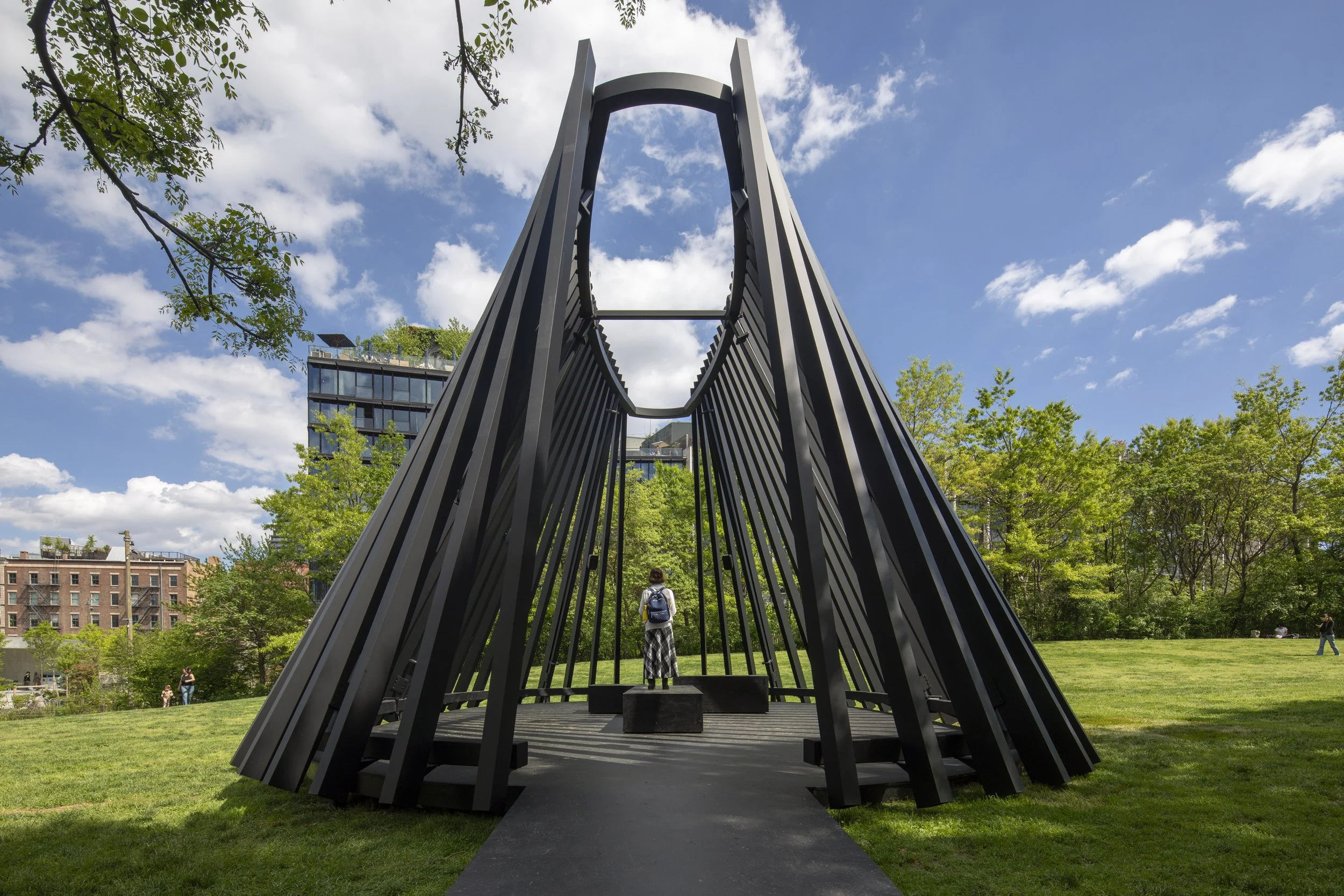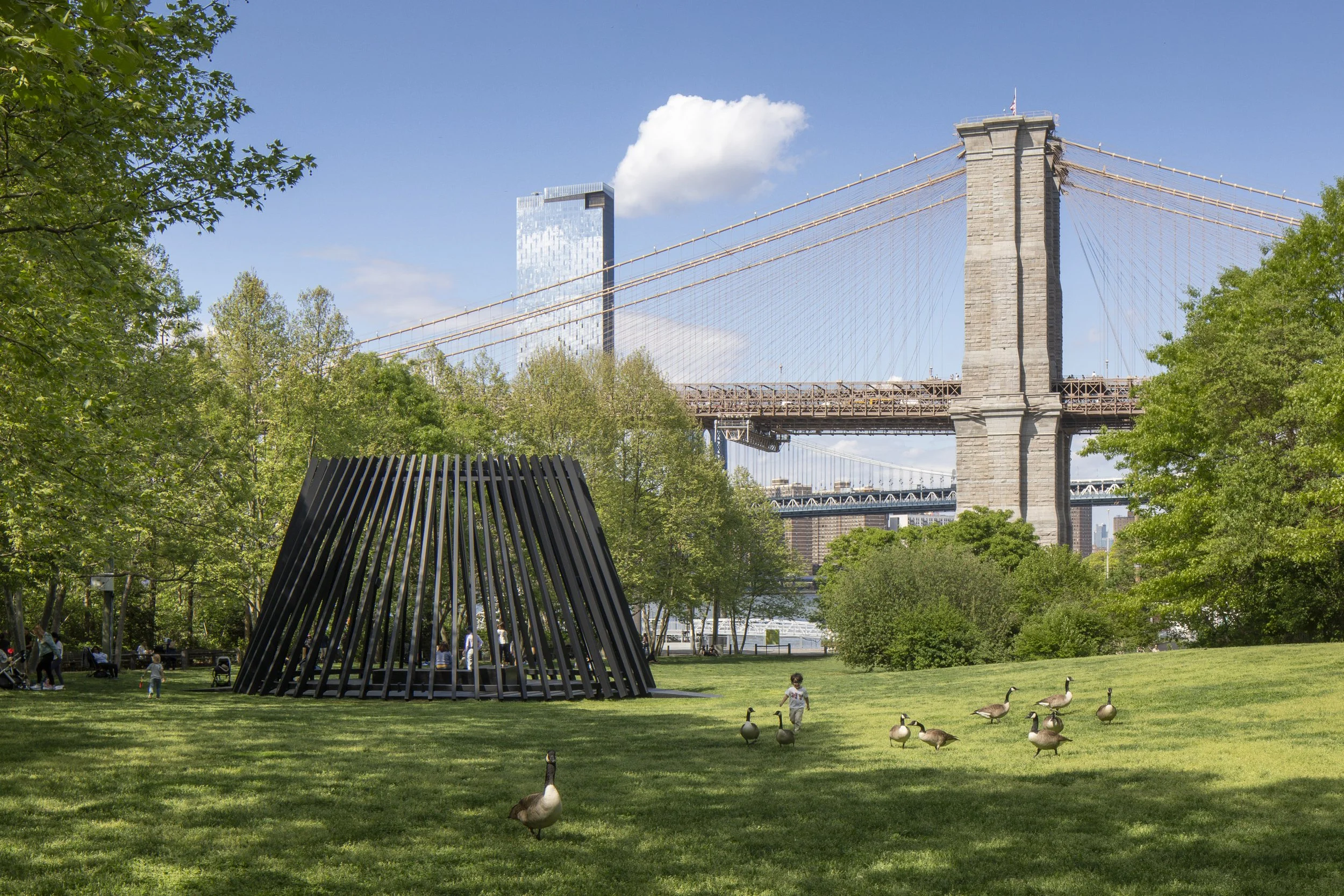Sound and Land in Torkwase Dyson’s “Akua”
Torkwase Dyson’s Akua is a large, open pavilion with an immersive multi-channel soundscape. Visitors may enter and experience recorded sounds moving across eight speakers, including layered conversations from Black archives, nature field recordings, and electronic sounds. For Dyson, sound is a physical vibration that can connect our bodies to our surroundings. The title Akua is inspired by the name of a family member; Akua means “born on Wednesday” in West African Akan tradition.
— Public Art Fund
Torkwase Dyson’s Akua (2025), curated by Public Art Fund Senior Curator Melanie Kress with Assistant Curator Jenée-Daria Strand, is an ode to the stories sewn into the ground on which it stands: Lenape land developed by minorities under Dutch and British rule. Akua is a space for meditation and serves as a place for visitors to engage with the installation on an audio-visual level; a combination that is a catalyst for deep reflection. Dyson’s investigation of sound is expressed through a multi-channel audio recording, composed of utterances and segments of Black women speaking in a variety of words, sounds, and poetry. The looped audio is intended for meditation, and its presence is meant to encourage Akua’s attendees’ minds to wander and meander into their imaginations.
Akua also explores breath as geography, with meditation and slow breathing as an aid for internal omnipresence, bringing participants back to whatever moments in time that their minds conceive. “The sound is intentionally ambient, so the source material is chopped, stretched, and sliced to create a sonic environment that encourages imagination,” Strand told me. As I encountered Akua, I felt my body physically connect to the work. A sense of relief, solitude, and tranquility washed over me as people sat in the surrounding grass, talking with friends, eating, and laughing. Time felt suspended; the installation’s opening towards the sky shifted me into spirituality and connection with an ever-present feeling.
“When I’m thinking about Black sound, I think about a community, a communing, around lifting up and turning sound into something that articulates all of our experiences,” relates Dyson. The artist ingrains elements of Black history and migration into the work. The installation’s placement beside New York’s East River directly acknowledges the artist’s and curator’s goal in telling a story representative of people within Black and indigenous communities. As gentrification continues to alter New York City into a place unrecognizable to many, landmarks and installations that are reflective of local history are imperative.
During my visit, I began to think about what Black history means in this geographical landscape. The city is an amalgamation of native and new: families, people, places, things, and sounds. Thoughts of displacement, segregation, diaspora, and exodus spanning across centuries all exacerbate the need for more multi-use artworks and installations that allow for deep contemplation of what this city means to so many stifled voices, all of which have looked, and are still looking, for their stories of movement, triumph, and existence to be shared and preserved.
The intertwined labors that built the country are eminent in Dyson’s work. “A lot of it comes both out of a long history of colonial projects and infrastructures that dispossess people of land. In those systems, what we know to be true is that people self-liberate,” she describes. Modes of self-liberation against colonial entities exist in art, protest, sound, and, as Dyson mentions frequently throughout her collection of work, community building and togetherness. Akua creates a physical space for those impacted by colonialism to sit in deep reflection—a protest of rest in a stillness is a privilege not awarded to many.
The artist’s Afro-futurist approach to creating is what I consider a nod to thinkers like Zora Neale Hurston and Octavia Butler, who both interacted with and explained the importance of ecology and land in their novels. Hurston’s Their Eyes Were Watching God explores the means of love, labor, and connection to the land on which the main character, Janie, works in the Everglades of Florida. Her closeness to nature, migration, and physical soil speaks to the need for a recognition of the importance of ecology and rootedness, which is mirrored in our everyday lives and our history. Butler’s Kindred is an account of slavery through time travel, addressing the longevity and impact of its trauma and America’s continued racial divides. Elements of both of these stories are ever-present, and Akua feels representative of these concepts.
There are so many relevant moments in history that were conjured up during my time with this artwork, such as the displacement that Hurricane Katrina caused. Water and movement are recurrent themes in the work, seen in the area as mass emigration from the city changed the population and demographics of New Orleans, while homes were destroyed and neglected at the hands of a colonial government. Similarly, many moments in history mirror this sentiment of resettlement, such as the Great Migration of the mid-twentieth century, where millions of African Americans moved from the South to the western and northeastern regions of the US to create better lives away from the effects of slavery, deep-Southern racism, and sharecropping.
The name Akua, of West African origin, further draws together these ideations of colonialism, movement, and discontentment in a land built by those who are disenfranchised and disrespected by overarching powers. The word itself has many meanings, one being health, fertility, and the birth of something new. In this artwork, Dyson reflects on the past, but also motions for the present to be more introspective—both internally and externally—for all parties that visit. Dyson may be suggesting that we apply the outcomes of these histories to our reflection on the legacy of culture not only in New York, but all over the world.
Torkwase Dyson: Akua is on view at Pier 1 Bridgeview Lawn, Brooklyn Bridge Park from May 6, 2025, through March 8, 2026.





